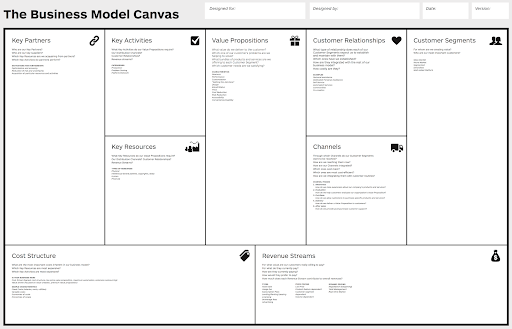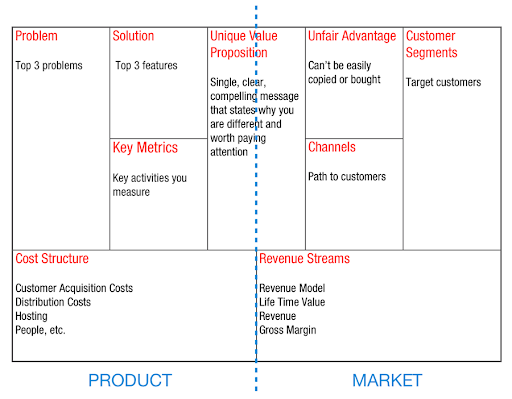To choose between lean canvas vs. business model canvas, you need to know the difference between them.
Both lean and business model canvas are visual representations of the reality in which your business operates. But, unlike the traditional business plan, they are sketches. You need to update them as you grow your business and learn.
The lean and business model canvas allows you to capture your business model on a single page. The main difference between them is that lean canvas zeroes in on solving a problem. Meanwhile, the business model canvas centers around selling a specific product.
In the post below, we explain this difference in more detail. After reading, you should be able to decide between lean canvas vs. business model canvas.
What is a business model canvas?

Source: Wikimedia Commons
Business model canvas is a visual template that helps entrepreneurs document an existing business model or develop a new one. Alexander Osterwalder created it in 2005, based on his academic work on business model ontology.
The business model canvas was designed with startups in mind. It quickly became an alternative to the traditional business plan which wasn’t agile enough to accommodate newly emerging companies.
The revolutionary thing about the business model canvas was that it allowed entrepreneurs to capture a business model on a single page. This made business planning simpler and more structured.
The 9 elements of the business model canvas, with examples from Google:
Key partners, e.g. Adsense network partners
Key activities, e.g. manage massive IT infrastructure
Key resources, e.g. IT infrastructure, intellectual resources
Value Propositions, e.g. free search engine, targeted ads
Customer Relationships, e.g. dedicated sales for large accounts
Customer segments, e.g. internet users, developers
Channels, e.g. global sales and support team
Cost structure, e.g. sales & marketing costs, admin costs
Revenue streams, e.g. ad revenues
Advantages of the business model canvas:
Defines key activities that generate value and revenue for the business.
Encourages strategic relationships with clients and partners.
Enables testing of an existing business model against the market.
Disadvantages of the business model canvas:
It doesn’t accommodate businesses in very early stages of development.
Enables risky assumptions within the business model, without offering a clear way to verify them.
Focuses on the end-shape of the business without defining the strategy to get there.
What is a lean canvas?

Source: Wikimedia Commons
The lean canvas is a variation of the business model canvas for lean startups. It was created by Ash Maurya who became concerned with risky assumptions enabled by the business model canvas.
In his own words: “My approach to making the canvas actionable was capturing that which was most uncertain, or more accurately, that which was most risky.”
Operating under high uncertainty is the main challenge for most startups. The lean canvas helps to solve this problem by framing business ideas as hypotheses at first. Additionally, it encourages focusing on the problem as the starting point for building a business.
This allows entrepreneurs to stay vigilant and adjust their business model as they grow, learn and iterate the product.
The 9 elements of the lean canvas, with examples from the Uber London
Problem, e.g. difficult to find a cab when you need it
Solution, e.g. guaranteed fast pick-up from your location
Key metrics, e.g. apps installed, journeys booked
Unique value proposition, e.g. taxi service, but cheaper, easier and safer
Unfair advantage, e.g. high brand awareness
Channels, e.g. friend referrals
Customer segments, e.g. young, internet-savvy Londoners and tourists
Cost structure, e.g. marketing, PR
Revenue streams, e.g. 25% of fare based on route and idle time.
Advantages of the lean canvas
It focuses on understanding the problem that the business is trying to solve.
Restrains the “solutions” box, encouraging simple and easily testable ideas.
Proposes key metrics to evaluate whether the business is moving in the right direction.
Accounts for uncertain conditions, assumptions, and incomplete data.
Disadvantages of the lean canvas
Overemphasizes the internal focus without accounting for the surrounding ecosystem.
Limits strategic thinking (as Ethan Mollick put it, by “focusing on what customers want today, rather than trying to see ahead into the future.”).
Lacks the “Resources” box which may lead to unrealistic product ideas.
The differences between lean canvas vs business model canvas
When Ash Maurya adapted the business model canvas for lean startups, he spotted four boxes that, according to him, weren’t crucial for startup founders. He replaced them with those that made more sense for lean startups.
Adding the “Problem” and removing the “Key Partners” box
Charles Kettering once said that “a problem well stated is a problem half-solved.” Ash Maurya also believes that identifying the problem should be the starting point for any business.
Many startups fail not because they can’t deliver the product, but because they misunderstand the problem they’re solving. The lean canvas makes sure the problem identification is a crucial step in the process.
Meanwhile, Maurya decided to take out the “Key partners” box. Even though he recognizes the need to create business partnerships, he says that “when you are an unknown startup with an untested product, pursuing key partnerships from day one can be a form of waste.”
With the lean approach, looking for partners comes later. The first concern is understanding the problem.
Adding the “Solutions” and removing the “Key Activities” box
The “Solutions” box in the lean canvas is small on purpose. This is aligned with the lean startup approach to MVP: developing a simple solution and checking if it works.
Incorporating “Solutions” (in plural!) in the lean canvas prevents entrepreneurs from blindly following their first idea. Having it as a part of the lean canvas makes it subject to verification - just like any other part of the business model.
At the same time, the “Key Activities” box from the original business model canvas was removed. That’s because key activities should derive from the “Solutions,” after they have been tested and validated through the MVP.
“Key metrics” instead of “Key Resources”
Key metrics were introduced to the lean canvas to give business owners a way to tell whether they’re on the right track.
Initially, startups may be drowning in all kinds of data and numbers. It’s important to discern which of them are important and indicative of growth. Using the wrong (or too many) metrics as signs of growth can lead to enormous waste.
Noah Kagan even said: “A startup can only focus on one metric. So you have to decide what that is and ignore everything else.”
Why were the “Key Resources” removed? Ash Maurya argues that in the digital age, new-product development isn’t as resource-demanding as it used to be. On top, some of the key resources can also fall into the “unfair advantage” box.
“Unfair advantage” instead of “Customer Relationships”
An unfair advantage in business is the shield against copycats and plagiarism. It’s the part of the business model that’s so unique and contextual that it’s extremely hard to replicate.
When Ash Maurya added this box to the lean canvas, he was aware that few startups find their unfair advantage straight away. On day one, this box can be blank. But over time, it should inspire business owners to look for their unfair advantage that makes their solutions hard to copy.
This box took the place of “Customer Relationships” in the business model canvas. That’s because startups don’t usually strategize their first relationships with clients. Rather, raw interactions emerge through customer interviews, product tests, and feedback.
Lean canvas vs business model canvas: which should you choose?
Both lean and business model canvas have advantages and disadvantages. Which one you’ll choose depends mostly on the angle from which you approach business.
Lean canvas is a simpler approach, focusing on solving one problem at a time. It can be used even when you’re starting from scratch and helps you brainstorm solutions. It’s a good way to start if you want to identify a problem first - and derive your product from that.
Business model canvas tends to work better when you’ve validated your initial hypotheses and already have a product. If your questions focus on how to make that product more profitable (or improve it in other ways), a business model canvas may be a good solution. It also gives you a more complete picture of your business model.
In other words, you could say that lean canvas focuses more on what of your startup, while the business model canvas digs deeper into the how.
Regardless of which one you choose, remember to update it over time. As your startup and the ecosystem around it change, your task as an entrepreneur is to learn from those changes




